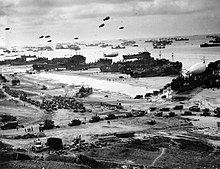
Back Operation Overlord ALS عملية أوفرلورد Arabic Batalla de Normandía AST Overlord əməliyyatı Azerbaijani اوورلورد عملیاتی AZB Операция „Овърлорд“ Bulgarian Operació Overlord Catalan Operace Overlord Czech Operation Overlord Danish Operation Overlord German
This article's citation style may be unclear. |
| Operation Overlord | |||||||
|---|---|---|---|---|---|---|---|
| Part of World War II | |||||||
 Tank landing ships unloading on Omaha Beach | |||||||
| |||||||
| Belligerents | |||||||
|
|
| ||||||
| Commanders and leaders | |||||||
|
|
| ||||||
| Strength | |||||||
| 1,332,000 (by July 24)[1] | 380,000 (by July 23)[2] | ||||||
| Casualties and losses | |||||||
|
July 24: ~120,000 casualties[1] |
July 24: 113,059 casualties[1] | ||||||
Operation Overlord was the 1944 campaign for the invasion of continental Europe in World War II. It was fought by the Allied forces against German forces. The most critical part was the Normandy landings, which were to get the Allied armies onto the mainland of Europe. That might have failed, and heavy casualties were expected, even if it succeeded.
The Battle of Normandy raged until German forces retreated across the Seine on 30 August 1944, which marked the close of Operation Overlord.
The main Allied forces came from the United States, the United Kingdom, and Canada. Nine other nations also sent units: Australia, Belgium, Czechoslovakia, France, Greece, the Netherlands, New Zealand, Norway, and Poland.
Preparations were large and complex. Operation Overlord was the largest and deadliest amphibious assault in the history of warfare. Almost three million troops crossed the English Channel from England to Normandy, in German-occupied France.[3]